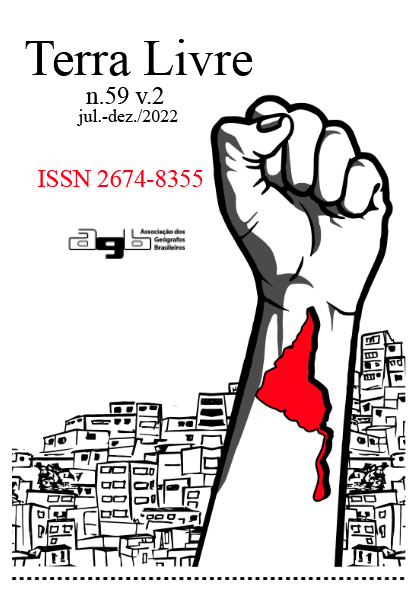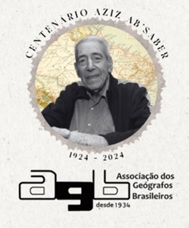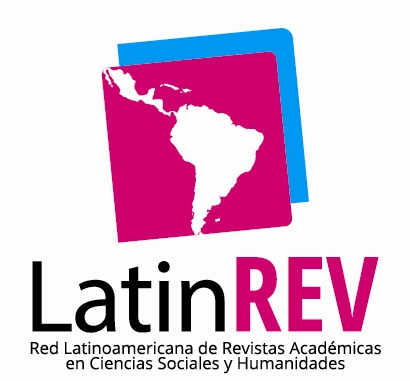THE GEOGRAPHY OF WOMEN IN PERIPHERIC BRAZILIAN FAMILIES
GENDER AND POLITICS IN THE FAMILY SPACE.
DOI:
https://doi.org/10.62516/terra_livre.2022.2914Keywords:
Geography of the Family, family, women, Female HeadshipAbstract
Still recent in Brazil, the perspective of the geography of the family analyzes the plurality of social relations in the family space, in the cultural dimension, in the spheres of power, among others. The optic of gender relations is crucial to understand the trajectories and strategies of families. And if we look at vulnerability and poverty, we will find many other categories of analysis. This article proposes to understand the range of relations between female headship and its characteristics in the urban peripheries of Brazil, based on fieldwork in the Metropolitan Region of Grande Vitória (ES). This theme is, therefore, a necessary effort both to analyze and to strengthen the studies on the geography of the family, which is pertinent if we consider the wealth of approaches and understandings possible in contemporary Brazil.
Downloads
References
BILAC, Elizabeth D. Estruturas familiares e padrões de residência. Campinas: Nepo/Unicamp, 2003.
BONNEY, Norman; MCCLEERY, Alison; FORSTER, Emma. Migration, marriage and the life course: commitment and residential mobility. Migration and Gender in the Developed World. London: Routledge, p. 112-121, 1999.
BOWLBY, Sophie. Women, Work and the Family: Control and Constraints. In: Geography. UK : Vol. 75, No. 1. pp. 17-26, 1990.
IBGE – INSTITUTO BRASILEIRO DE GEOGRAFIA E ESTATÍSTICA. Censo Brasileiro de 2010. Rio de Janeiro: IBGE, 2012.
LAWSON, Victoria A. Hierarchical households and gendered migration in Latin America: feminist extensions to migration research. Progress in Human Geography. N. 22, V. 1. Manchester, p. 39-53, 1998. DOI: https://doi.org/10.1191/030913298677526732
MARTINS, Isis do Mar Marques. Geografia da família, aspectos teóricos e abordagens qualitativas: uma introdução. Geografares, [S. l.], v. 1, n. 34, p. 94–111, 2022. DOI: https://doi.org/10.47456/geo.v1i34.38506
McKIE, Linda; BOWLBY, Sophia; GREGORY, Susan. Gender, Caring and Employment in Britain. Journal of Social Policy. N. 30: Cambridge, p. 233-258, 2001. DOI: https://doi.org/10.1017/S0047279401006262
MOREIRA, Marianna Fernandes. Mulheres sem-teto e a geografia da família: relações interdomésticas, gênero e reciprocidade. Espaço e Cultura, n. 38, p. 85-122, 2015. DOI: https://doi.org/10.12957/espacoecultura.2015.29071
ROSSINI, Rosa Estér. Geografia e gênero: a mulher na lavoura canavieira paulista. Tese de Livre Docência apresentada na FFLCH/USP, 1988.
VALENTINE, G. The ties that bind: towards geography of intimacy. Geography compass. Vol 2 (6): Leeds, p. 2097-2110, 2008. DOI: https://doi.org/10.1111/j.1749-8198.2008.00158.x
Downloads
Published
How to Cite
Issue
Section
License
Esta Revista está licenciado sob uma licença 
Os Direitos Autorais dos artigos publicados na Terra Livre pertencem ao(s) seu(s) respectivo(s) autor(es), com os direitos de primeira publicação cedidos à Terra Livre.
Os artigos publicados são de acesso público, de uso gratuito, com atribuição de autoria obrigatória, para aplicações de finalidade educacional e não-comercial, de acordo com o modelo de licenciamento Creative Commons 3.0 adotado pela revista.

A Terra Livre está licenciada sob uma licença Creative Commons Atribuição-NãoComercial-CompartilhaIgual 3.0 Não Adaptada.
Você é livre para:
- Compartilhar — copie e redistribua o material em qualquer meio ou formato
- Adaptar — remixar, transformar e construir sobre o material
- O licenciante não pode revogar essas liberdades, desde que você siga os termos da licença.
Nos seguintes termos:
- Atribuição — Você deve dar o crédito apropriado , fornecer um link para a licença e indicar se as alterações foram feitas . Você pode fazê-lo de qualquer maneira razoável, mas não de qualquer forma que sugira que o licenciante endossa você ou seu uso.
- Não Comercial — Você não pode usar o material para fins comerciais .
- ShareAlike — Se você remixar, transformar ou construir sobre o material, você deve distribuir suas contribuições sob a mesma licença que o original.
- Sem restrições adicionais — Você não pode aplicar termos legais ou medidas tecnológicas que restrinjam legalmente outras pessoas de fazer qualquer coisa que a licença permita.












